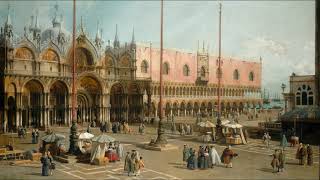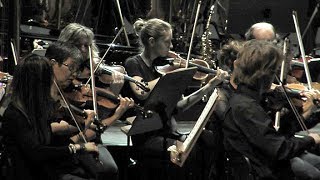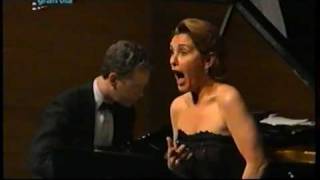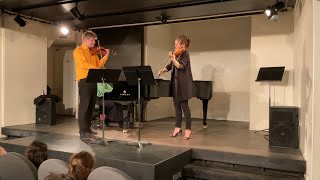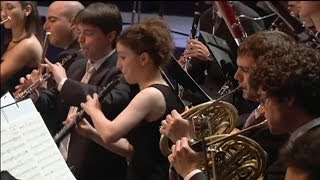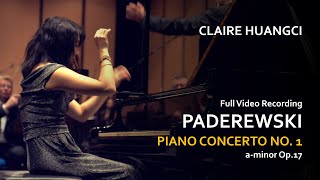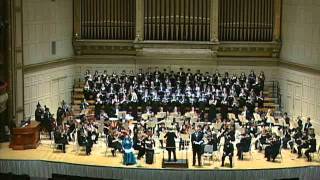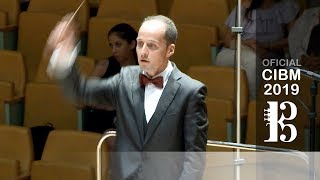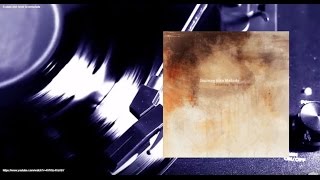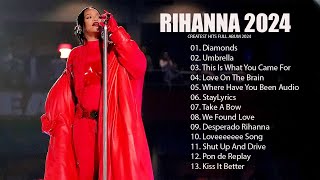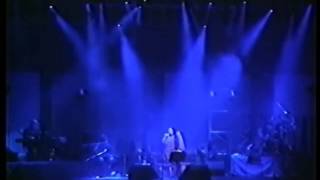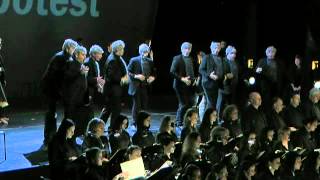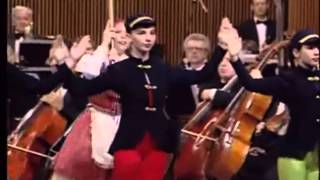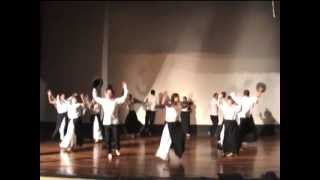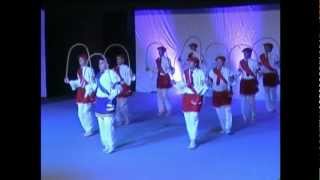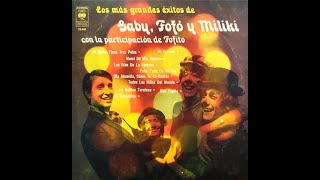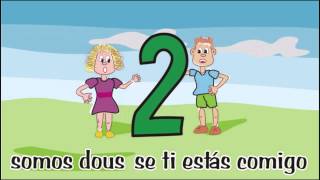Recommended music videos for initiation to classical music
Georg Friedrich Handel ( 1685-1759) born in Halle , Germany, is one of the leading figures in the History of Music and, of course, of the Baroque (1600-1750). He wrote numerous operas, cantatas and oratorios, among which we must highlight his masterpiece, the Oratorio El Mesías . At the age of 18 he moved to Hamburg where he joined the Opera Orchestra . After three years, he traveled to Florence and then to Rome . In 1710 he returned to Germany and from there to London where he settled under the tutelage of different patrons. Although he was always very jealous of his private life, there are innumerable indications that make us assume his homosexual inclination. In London he acquired his British nationality and was appointed manager of the Opera House until his death in 1759.
The concerto grosso (in the plural, concerti grossi ) was a Baroque instrumental form of Italian origin based on the contrast between a small group of soloists ( concertino ) and a full orchestra ( ripieno or tutti ). The concerto grosso dates from about 1670 and can be attributed to Alessandro Stradella , who appears to have written the first musical work in which a "concertmaster" and a "ripieno" characteristically face each other, despite not using the term concerto grosso . Giovanni Lorenzo Gregori is the first composer to use the term concerto grosso and Arcangelo Corelli its main representative.
The Concerti grossi, op. 6 , are twelve concerti grossi by Georg Friedrich Händel for a concertmaster trio made up of two violins and cello and a ripieno in four parts, string orchestra and harpsichord, carrying the basso continuo. He takes as models the ancient concerto da chiesa and the concerto da camera of the Arcangelo Corelli tradition, rather than Antonio Vivaldi 's late three-movement Venetian concerto favored by Johann Sebastian Bach . They were written to be played as an interlude during performances of Handel's oratorios and odes. The concertos are among the best examples of the concerto grosso baroque genre.
Today they are offered to us by The Academy of Ancient Music Orchestra under the direction of its principal violin (concertmaster) Andrew Manze .
Johann Strauss Jr. (1825-1899) was an Austrian composer, son of Johann Strauss and brother of composers Josef Strauss and Eduard Strauss ; Known during his lifetime as "the king of the waltz", he was an essential factor in its evolution and sophistication, from being a peasant dance to an entertainment dance for the Imperial Court . He is the best known of the family for his waltzes, his polkas and his marches; composer, in addition, of several operettas. His father wanted to prevent his son from going through the straits of a musician's life, so it was his mother who helped him and encouraged him to focus on music. His work forms the basis of the repertoire offered annually at the Vienna Philharmonic Orchestra 's New Year's Concert .
The Polka (or polka) is a popular dance that appeared in Bohemia (now the Czech Republic) around 1830, which began to become popular in Prague from 1835. Its music is written in 2/4 time and fast time; it is danced with lateral steps and rapid evolutions; It became very popular in Europe and America .
Today we attend the interpretation of the Polka Tik Tak, which is reminiscent of a clock (as its name suggests) and is part of the operetta "Die Fledermaus" performed at the New Year's Concert in Vienna in 2012 directed by the Latvian maestro Mariss jansons.
Amadeo Vives (1871-1932), a composer born in Barcelona , is the author of numerous songs and more than a hundred stage works, including Bohemios, Maruxa and, above all, Doña Francisquita , considered among the masterpieces of the genre. . He began receiving music lessons from his brother at the age of five; later with José Ribera he would study piano, harmony and composition; he collaborated with Lluis Millet in the founding of the Orfeó Catalá , which would begin its journey with Catalan songs harmonized by Amadeo Vives . At the age of fourteen he had composed several sonatas and at the age of 24 he premiered his first opera in Barcelona . Later he moved to Madrid where his stage premieres received successful responses and recognized prestige.
Doña Francisquita is a zarzuela, called a "lyrical comedy", in three acts, with a libretto by Federico Romero Sarachaga and Guillermo Fernández-Shaw Iturralde , based on the comedy La discreta enamorada by Félix Lope de Vega , with music by maestro Amadeo Vives ; It premiered at the Teatro Apolo in Madrid on October 17, 1923. It is considered one of the greatest works of zarzuela, setting a model within the great genre. The libretto portrays the romantic Madrid in a poetic and faithful way, creating pictures of great color and vividness, without falling into mere historical recreation, this being a work full of freshness. Due to its characteristics, it can also be defined as a high-quality comic opera.
María Bayo (1961 Fitero , Navarra/Nafarroa) is a soprano who has developed an outstanding international career as an opera, zarzuela and classical song performer. Although he was born in a hospital in Tudela , he considers the town of Fitero , where his family resides and with which he maintains close ties, his hometown. She has been awarded first prize in the Belvedere competition in Vienna , the National Music Award , the Prince of Viana Award for Culture ; She has been invested as an elected member of Jakiunde , awarded with the Eusko Ikaskuntza-Caja Laboral Humanities Award , with the Traetta Award from the Traetta Society, with the Cadenas de Navarra Award ... In 2020 she received the Gold Medal for merit in the Fine Arts .
Today he offers us the romance of Doña Francisquita , Song of the nightingale accompanied on piano by Brian Zeger .
Dmitri Shostakovich (1906-1975) is one of the most recognized composers of the 20th century , who had to adapt to the political status with which he had to live. His music was sometimes denounced as decadent and reactionary and sometimes praised as representative of the new socialist art by the CPSU . In public, he was always loyal to the system and held important responsibilities in art institutions, agreeing to join the CPSU in 1960 and becoming a member of the Supreme Soviet . He wrote fifteen string quartets, another fifteen symphonies, six concertos, several operas, as well as film and ballet music. His music stands out for its relevant contrasts and original rhythmic aspects in which an energetic, sometimes burlesque character underlies.
Today they violinists Nicolas Dautricourt and Claire Bucelle with pianist Michèle Pondepeyre offer us Shostakovich 's Prelude for two violins and piano .
Recommended classical music videos
Ludwig van Beethoven (1770-1827) together with Bach and Mozart is part of the trio of giants of Western music. Born in Bonn , his father, of Flemish origin, tried to make a second Mozart of him, though it was a notable failure. Despite this, from the age of nine, the organist Christian Gottlob Neefe captivated him with the study of Bach , whom he would always keep in mind. In 1787 he moved to Vienna with the intention of receiving Mozart classes, but the death of his mother brought him back to Bonn after a few days. And so after five years, he returned to Vienna where he made contact with Haydn and Salieri , making himself known as a composer and pianist with well-known public recognition. However, his profession as a pianist could not be carried out due to the deafness that attacked him the following year until he was totally disabled from said faculty.
Symphony No. 2 in D Major, Op. 36, opens with a slow and powerful introduction, I (0´25´´) ADAGIO MOLTO, full of dramatic gesture, which ends in a (3´14´´) ALLEGRO CON BRÍO full of energy. Then follows a II (11'00'') LARGHETTO, noble and pastoral in character, full of lyrical themes, of great serenity and beauty. Next, instead of the usual Minuetto-Trio , Beethoven introduces, for the first time, a III (22'06'') SCHERZO -"game" or "joke" in Italian-, which gave the composition a great dimension and energy. The set closes with an explosive IV (25´ 46´´) FINALE ALLEGRO MOLTO, a movement of such depth and harmonic complexity that it was described, on the day of its premiere, as a "repulsive monster, a wounded serpent, striking wild and furious blows while driving to his death agony."
Daniel Barenboim ( Buenos Aires , November 15, 1942) is an Argentine nationalized Spanish, Israeli and Palestinian pianist and conductor and son of musicians with whom he began his piano studies at the age of five. He then studied with Nadia Boulanger, Igor Markevitch, and at the Academy of Santa Cecilia in Rome . His debut as an opera director took place in 1973. Between 1975 and 1989 he was music director of the Orchester de Paris . In 1981, he made his debut at the Bayreuth Festival . From 1991 until June 17, 2006, he was the conductor of the Chicago Symphony Orchestra . Since 1992 he has also been the General Music Director of the Berlin State Opera and has conducted the most important orchestras in the world. In 2009 and 2022 he conducted the New Year's Concert of the Vienna Philharmonic Orchestra .
Ignacy Jan Paderewski (1860-1941) was a Polish pianist, composer, diplomat, and politician; he was the third Prime Minister of Poland . He studied at the Warsaw, Berlin , and Vienna conservatories. His debut in Vienna , in 1887, and his performance two years later in Paris , earned him the fame of being, after Franz Liszt , the best pianist. His interpretations of the works of the Polish composer Frédéric Chopin were widely admired. After 1900 he seldom appeared in public and was becoming better known as a composer, especially of piano pieces. In 1901 he created his opera Manru , a symphony, concertos, as well as orchestral and piano pieces, of which his popular Minuet in G stands out.
The Piano Concerto in A minor , Op. 17, is the only piano concerto written by Paderewski; it was written in the composer's twenties, with the first movement dating from 1882, although most of the work was composed in 1888 and set to music in 1889. After its completion, the composer showed the concerto to his friend Saint-Saëns , who admired him It premiered the same year in Vienna , achieving great success, where it was directed by Hans Richter . The concert is structured in three movements: I (0´00´´) HAPPY (Cadence: 12´26´´) .-. II (15'18'') ROMANCE. WALKING .-. III (24'52'') FINAL. ALLEGRO MOLTO VIVACE.
Today it is offered to us by the American pianist Claire Huangci accompanied by the Deutsche Radio Philharmonie conducted by the Canadian maestro Yves Abel .
Felix Mendelssohn (1809-1847) was a German pianist, conductor and composer of outstanding technical and formal perfection. Child prodigy who at a very early age showed his extraordinary abilities and brother of the pianist and composer Fanny Mendelssohn , also a child prodigy. He began by receiving piano lessons from his mother; At the age of eighteen, he entered composition classes based on Bach 's Well-Tempered Clavier . In this way, Mendelssohn 's works show a well-established tonal clarity and a deep mastery of counterpoint. His legacy includes piano music, organ music, chamber music, overtures, symphonies, concertos, oratorios, and incidental music.
Elijah (Elías) Op. 70, MWV A 25, is an oratorio with music by Mendelssohn and a libretto by Julius Schubring . Describes events from the life of the Biblical prophet Elijah , drawn from the Old Testament Books of Kings . In 1829 Mendelssohn had organized the first public performance since the composer's death of Bach 's St. Matthew Passion and was a driving force in spreading and popularizing Bach 's works. By contrast, Handel 's oratorios never went out of fashion in England. Mendelssohn prepared a scholarly edition of some of Handel 's oratorios for publication in London . Elías is inspired by the oratorios of these two baroque masters; even so, in its lyricism, orchestral and choral color, it reflects Mendelssohn 's own style and the peculiarities of Romanticism .
The Oratorio , structured in two parts (1'04'' and 1h 10'04''), is offered to us by the sopranos Liz Baldwin and Kira Winter , the mezzo-soprano Penelope Bitzas , the tenor Martin Bakari , the baritone James Demler with the Orchestra and Boston University College Symphony Chorus ; all of them led by teacher Ann Howard Jones .
Bart Picqueur (1972) is a Belgian composer, music educator, conductor and clarinetist, who studied music at the Royal Conservatory of Ghent . As a conductor, he was/is active in the world of wind music by, among others, Musikalo Sint-Katherina-Lombeek (1996-2004), Youth Harmony de Koninklijke Harmonie "St.-Cecilia" , Zele (1990-) and the Koninklijke Stedelijke Harmonie Hulst in Holly (2004-2010). He is also co-founder and director of " WonderBrass AweFul PowerBand ". As a composer he had great success with the musicals Devil's Paradise (1997) and Jan Praet (2000). As an arranger, he arranges classical and light music for, among others, Dirk Brossé , the Belgian National Orchestra , for the Remuze Festival , the Hasselt Proms and many wind orchestras.
A Little Gipsy Symphony is a symphony composed by Bart Picqueur inspired by Bulgarian popular music and structured in three movements (I: 0´00´´.-. II: 6´52´´ .-. III 11´´).
Today it is presented to us by the Gran Canaria Wind Orchestra, a referential formation of the Islands born in 2014, conducted by its owner David Fiuza Souto , (1985, Pontevedra).
Recommended music videos for all tastes
Stanley Turrentine (1934-2000) was an American jazz musician and tenor saxophonist. A legendary figure on his instrument, Turrentine 's style spans hard bop and jazz fusion . His way of playing is characterized by a baroque, dense sound, rooted in the blues , and by a constant imagination and sensitivity in improvisation. Turrentine began his career playing with various blues and R&B groups, heavily influenced musically by Illinois Jacquet . In 1950 and 1951, he played with Ray Charles in blues guitarist Lowell Fulson 's band. Later, he would join the band led by Charles . In the early 1970s, Turrentine became a mainstay of the jazz fusion-oriented label CTI,34 ; Otherwise, he continued to record extensively and returned to soul jazz in the '80s and '90s.
Rihanna (1988) is a Barbadian- born singer, businesswoman, fashion designer, actress, diplomat, writer, dancer, and philanthropist. She is known for fusing Caribbean genres with pop music and for reinventing her image over the years. Her impact on popular culture has led her to become a music and fashion icon, for which she is referred to as the Princess of R&B and Queen of Fashion and is considered one of the most influential music artists and successes of the 21st century . He gained worldwide fame after the release of his third studio album, Good Girl Gone Bad (2007). With more than 250 million musical productions distributed throughout her career worldwide, Rihanna is one of the best-selling artists of all time.
Paco de Lucía (1947-2014) was an Andalusian guitarist considered the best flamenco guitarist of all time. He began his musical education with his father, also a guitarist, and soon came into contact with and influenced by Niño Ricardo and Sabicas . With his brother Pepe he was part of the group Los Chiquitos de Algeciras ; later he collaborated with Fosforito and with El Lebrijano . With the passage of time, he began to make contact with new styles and collaborate with different artists of ethnic music, jazz, bossa nova, and even classical music ; he began the reform of flamenco while involving artists of the stature of Tomatito and Camarón de la Isla in the work. He recorded 38 albums, toured successfully in Europe, America and Japan and received numerous important awards.
Mercedes Sosa (1935-2009) was an Argentine folk music singer, considered the greatest exponent of Argentine folklore. It became known as The Voice of Latin America . Founder of the New Songbook Movement and one of the exponents of the New Latin American Song . He ventured into other genres such as tango, rock and pop . She defined herself as a "singer" rather than a "singer", a fundamental distinction of the new Latin American song of which she was one of the initiators: "Singer is the one who can and singer is the one who must" ( Facundo Cabral ). She was awarded with honors in 2005 by the Argentine Senate with the Sarmiento award in recognition of her artistic career, her social commitment and her constant fight for human rights.
Recommended peculiar videos
Carl Orff (1895-1982) was a German composer, whose work can be framed within the current of musical neoclassicism . He was known for his work Carmina Burana , from the triptych of scenic cantatas to which Catulli Carmina and the Triumph of Aphrodite also belong; His name has also been universally disclosed for developing a musical teaching system for children (known as the Orff method ) that has had notable results. Orff began playing the piano at the age of five, and also took organ and cello lessons. However, he was more interested in the composition; so from an early age Orff wrote and staged puppet plays for his family, with music for piano, violin, zither, and glockenspiel to accompany his plays.
Catulli Carmina (Songs -or Words- of Catullus ), from which we offer a selection today, is a scenic cantata composed by Carl Orff , premiered in 1943 in Munich and based on the texts of the Latin poet Gaius Valerius Catullus (84-54 BC ). It is written for two soloists, a mixed choir, a large percussion group and four pianos. The work experiments with the repetition of phrases and syncopated rhythms, along the lines already used in Carmina Burana , taking this game even further. This composition is another example of Carl Orff 's brilliant use of orchestra, percussion and stage action, displaying interesting sung stage play. Today we present a selection of the work whose musical direction is provided by Roman Válek , while the choreography is performed by Ladislava Košíková .
Zoltán Kodály (1882-1967) was a Hungarian composer committed to the folklore of his country (he collected more than 100,000 popular songs) and musical pedagogy. He began his studies in Galánta and later in Budapest . In 1907 he met Debussy , whose music had a profound impact on him. He worked jointly and deeply with Béla Bártok , who laid the foundations of what we know today as Musical Ethnomusicology . As a composer, he regularly uses both popular melodies and scales, giving relevance to his choral works. As a pedagogue, he marks a milestone in history and his Kodaly Method , in which the voice is the main instrument, is still valid.
Háry János is a "Hungarian folk opera" (i.e. a spoken work with songs, in the manner of a Singspiel) in four acts with music by Zoltán Kodály based on a Hungarian-language libretto by Béla Paulini (1881-1945) and Zsolt Harsányi , based on the comic epic The Veteran (Az obsitos) by János Garai . It premiered at the Royal Opera House in Budapest , in 1926. Today we present his Viennese Musical Clock in an interpretation by the Israel Philharmonic conducted by maestro Arie Vardi
The San Juanito is the national dance of Ecuador . This dance has its origins long before the time of Spanish colonization and is said to have been practiced by the Incas as a type of ritual to honor the god Inti . Perhaps in its beginnings this dance did not have this name, since this denomination has a Christian heritage and is an example of the many practices of cultural appropriation, since this name is in honor of San Juan Bautista (Extracted from Factory Tap) . Today it is staged for us by the group of Teachers of the Rafael María Carrasquilla School.
Oñatiko Arku dantza The most important festival in Oñati , Gipuzkoa, is Corpus Christi . In the morning, after the High Mass , there is a procession with the sacred characters and the dancers, who dance again in the afternoon. One of the dances is the Arku Dantza (Arch Dance), which we offer today by the Itxas Alde Dantza Taldea group. ( Extracted from the comment of this video )
Recommended music videos for children
Various Wikipedia articles have been used to write these texts.
The texts of Videomusicalis are written in Basque, Spanish and English.





